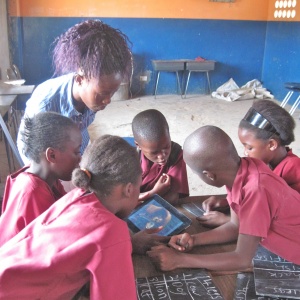OER4Schools/Collaborative writing with EtherPad
Classroom activity: Collaborative writing with EtherPad
| Resource details | |
| Title | Collaborative writing with EtherPad |
| Topic | [[Topics/Collaborative writing|Collaborative writing]], [[Topics/OER4Schools|OER4Schools]], [[Topics/Teacher Education Resources for Sub-Saharan Africa|Teacher Education Resources for Sub-Saharan Africa]] |
| Teaching approach | [[Teaching Approaches/|]]
|
| Subject | [[Resources/Teacher Education|Teacher Education]] |
| Age of students / grade | [[Resources/|]]
|
| Acknowledgement | This resource is part of the OER4Schools programme. |
1. Share out all the netbooks – make equal sized groups (or pairs if there are enough machines). Groups needs to have mixed reading and writing ability.
2. Learners open them and go to EtherPad. Each group makes up a group name and types it in in capitals, eg WHALES. Teacher writes the name of the topic on the board, eg. “what foods are healthiest for children to eat” or “a story about a magic stone”.
3. Each child then types their own name underneath the group name (not capitals, eg “Melvin”) so they all get a chance to practise typing, and so who the group members are is clear to others.
4. Each group brainstorms words related to the topic that they might want to use in a story or piece of writing. They type the words straight into the Etherpad under their group names (leave a blank line under the names), sharing and rotating the netbook so again everyone generates and types at least one word.
Encourage them to be imaginative! If they don’t have many ideas, ask a few open-ended questions to start them off (e.g. “What hobbies do people you know have?” “What could a magic stone be used for? What problems might arise if it could really do anything its owner wanted?”)
5. When you judge that they have written enough (a few words per group is fine), ask them to look at the other groups’ words (but not before, so they don’t copy). Show them how to scroll if necessary. Discuss with them how many words are the same across groups. Are there any particularly interesting or novel words? If so, point them out and ask the author to explain how their word fits the theme, but don’t spend too long on this. If there are spelling mistakes, ask other children to correct them.
6. Each child writes a short story or factual paragraph in their books, drawing on the words generated by the class; they should try to include as many as they can, forming proper sentences with them, and adding in any other words they want to. Ask them to try not to repeat words but to make the sentences as varied as they can, and to make sure they include some ideas from other groups as well as their own.
Learners should pay the usual attention to punctuation, grammar etc, as appropriate for their age. Teacher circulates to see how they’re doing and illustrates / reminds them of what they need to do if necessary, but lets them make their own choices about what words to use.
Differentiation: Some learners will be faster than others; allow the slower ones to write less in the time available, but encourage the faster ones to write longer pieces using more of the shared words, and to proofread carefully what they have written.
Alternative: You might want the group to write the story or paragraph together instead? So only one child writes while all of them make up sentences. Only one book will contain the writing of course, but the group may benefit from having collaborated. Or they can work together anyway and each write the same sentences down, helping each other with spelling and punctuation.
Alternative: If you found a group was particularly adept at using the computer earlier, they can try typing their story into Etherpad, working together on a single story. But if they are very slow at typing, they should write by hand instead.


